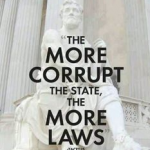
How Future Generations Will See Today’s Financial Repression

If you were to look around you (during your trip to the future) and perhaps wander into a college class on economics, chances are you would soon encounter a lecturer talking about the “Great Economic Collapse” of the early 21st century. In other words, talking about where we are right now.
When those lecturers talk about the Great Economic Collapse (in our imaginary future), chances are that the single most critical aspect of their discussion will boil down to this: how is it possible, they will ask, that the people alive at that time did not notice what was taking place all around them?
How is it possible, they will ask their students, that the public of that era (our era) sat back in total stupefaction while…
* Multiple banks, financial agencies and even government regulators not only did nothing to prevent the “bad paper” collapse of 2007—the one immortalized in The Big Short movie—but, in many cases, actually participated in the fraud, and profited handsomely from such participation?
* Faced with overwhelming evidence of the culpability of key banks and conspirators, the democratically elected government of the day not only did nothing but, astonishingly, went one step further and declared most of the bad actors “too big to fail” and then handed them billions of dollars shortly—and appropriately—before Christmas, dollars which had been entrusted to them by the public?
* Shortly thereafter, the Federal Reserve (an agency no more “federal” than Federal Express)—working in conjunction with other so-called central planners around the globe—in full view of the wide-eyed public, intervened in the interest rate market and basically hijacked it, usurped it, and bent it to their will, which ushered in an era of ultra-low rates that not only failed to generate any obvious benefits for Main Street, but paradoxically, rewarded the corporations, banks, and already-rich to a degree that was literally beyond imagination.
Faced with overwhelming evidence that their policies were not working for the intended purpose—and, in fact, were creating new and dangerous market distortions—these same central planners not only stubbornly continued the madness and mayhem, but they also actually took it to a new level. (ZIRPs, or zero interest rate policies, morphed into NIRPs, or negative interest rate policies, in most parts of Europe.) Didn’t Einstein once say that the essence of stupidity is repeating the same action over and over and expecting a different result?
During this same period, the only entities jumping for joy under these regimes were the trading houses (borrowing at zero means making a profit on any investment yielding more than zero!) and the corporations, which discovered that by borrowing at low rates to buy back their own stock, they could reduce their “float” (make less stock available) and therefore drive up the price of the remaining stock, making themselves look clever (even though THEY WERE NOT) and earning massive executive bonuses in the process. (It is my often-stated view that historians of the future will look back at quantitative easing as a mechanism to benefit the banks and ultra-rich, and little else.)
Nor can it be said that the public of the era (our era) was not offered objective information with which to make sense of this. During these troubled times, any brave soul who would have googled the term “financial repression” would have learned that all these strange measures, taken as a whole, were simply part of what governments “do” when they get in deep trouble and need to bail themselves out at the expense of the very same electorate who foolishly gave them power in the first place!
EXTRACTED FROM: The Coming Great Pension Collapse—How, Why, Where




 06/18/2016 - How Future Generations Will See Today’s Financial Repression
06/18/2016 - How Future Generations Will See Today’s Financial Repression



